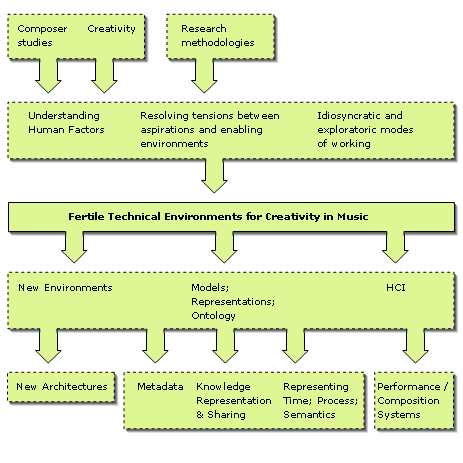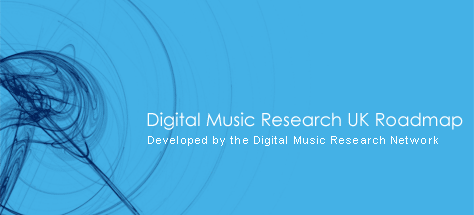- Machine
Listening
- Fertile environments for creativity
- Music Exploitation and Distribution
- Musical Innovation
- High-Level Parametric Control
- Sound Reproduction and Recording
- Fertile environments for creativity
- Music Exploitation and Distribution
- Musical Innovation
- High-Level Parametric Control
- Sound Reproduction and Recording
Research Goals in Digital Music: A Ten Year View
 Fertile Environments
for Creativity
Fertile Environments
for Creativity
Experimental and commercial computer systems have been designed to allow composers
and musicians to create musical compositions and performances using sound synthesis,
digital signal processing algorithms and other musical tools. However, currently
there is insufficient understanding of relevant human factors associated with
the creative process. In particular, there is a need for research into the nature
of creativity in digital music, such that the causes of tensions known to exist
between composers and performers and the technological systems they use, can be
better understood. Such knowledge will provide a sound theoretical basis for the
engineering of technological systems which address these potential tensions, and
thus provide more fertile environments for creativity in digital music.

Research into human factors in digital music is likely to have wider implication, since it will enhance understanding of many creative activities, and contribute to the research base to underpin the design of systems in other domains. For example, creativity is a critical driving force in science, commerce and manufacturing.
Currently, we lack research methodologies to elicit this knowledge, but over the next ten years inductive qualitative methodologies need to be developed to study professional composers and musicians at work. These methods are needed to complement those used in experimental psychology and the naturalistic study of creativity. They will better capture and analyse data to provide rich and holistic descriptions of creative activities in digital music.
An important research challenge is to establish a research base relating to human factors of composition and performance of digital music, as a basis for the engineering systems for creativity in digital music. This area is intrinsically transdisciplinary requiring expertise from perspectives of music, information science, psychological and cognitive studies, computer science and signal processing. Further, the problem domain is complex and diverse, involving idiosyncratic users with roles ranging through music production, creation, distribution and consumption.
The research must address two broad challenges, (i) to gain a richer understanding of human factors pertaining to digital music systems (represented in the top half of the diagram), and (ii) to utilize that knowledge to synthesise engineering principles for the development of improved systems (the bottom half of the diagram). In (i), objectives must be:
- To develop research methodologies to investigate human factors relating to creativity in digital music;
- through the application of these methodologies, to achieve a better understanding of such human factors. In particular, this will involve studies of composers and musicians "at work";
- better understanding of the causes of potential tensions, known to exist, between technological enabling environments (composition and performance systems) and their users (composers and musicians);
- to research the means of removing or reducing those tensions in order to make the enabling environments more fertile for creativity.
- The development of new technological environments to support creativity in digital music. This investigation must go beyond consideration of novel tool sets, so as to address the architectural contexts within which those tools are made available and the associated services provided to the users;
- to develop models, meta-models and ontologies for the representation of digital musical information and knowledge. Considerations should include the representation of metadata such that information is machine understandable, and the representation of individual and community know-how. The models should also address challenging aspects of musical information, such as the representation and manipulation of time- and process-related information at the different levels of abstraction relevant to creative processes, ranging from the physical to the perceptual and aesthetic;
- to develop human-computer interfaces better suited to supporting creative activities in composition and performance.
[Top]

